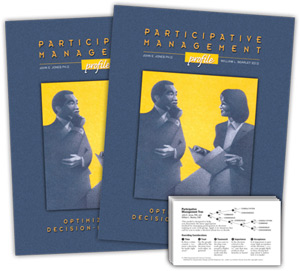PARTICIPATIVE MANAGEMENT PROFILE

by William Bearly and John Jones
The importance of helping leaders explore participative management became apparent as the amount of confusion on the subject increased. Participative Management Profile fills the need to have an inventory that not only clears up the ambiguities but provides simple, straightforward self-assessment and feedback.
Overview
Building on the previous research, we chose to create the Participative Management Profile (PMP) as a model-based assessment rather than use empirically-based scaling. In other words, we built a model based on the research and determined scales using the model rather than using statistical analyses. The model that PMPimplements is normative; it specifies that under certain conditions there is a "one best way" decision-making mode. The PMP incorporates what we see as the five major aspects of an optimized, decision-making process.
Although the instrument provides a style profile, we believe that style is less important than clear thinking about decisions and sensitivity to the needs of group members. The danger in focusing on style is that the leader will see his/her profile as a set of fingerprints that are difficult to change. We believe that a leader can use any method of decision making well or badly, and the difference comes from his/her analysis of situations and knowledge of probable group member reactions. The PMP emphasizes effectiveness over style.
Development
The development of the PMP centered around enhancing the Maier (1963) model and writing items that illustrated the conditions under which various modes of decision making were indicated. We included 20 common work situations that were not restricted to business or for-profit settings - ones with which most respondents would be able to identify. The items were written to the model, five items per decision-making mode. The instrument was then completed by creating an easy scoring system, interpretive material, and an opportunity for doing some action planning.
In each of the 20 situations represented by the PMP, there are cues to which the respondents reacts in deciding how to decide. Not every situation contains answers to all five of the questions from the "Participative Management Tree." Overriding considerations in some of the situations make it unnecessary to include complete information. The items should not be thought of as miniature case studies.
Administering the PMP
The PMP is an instrument intended for use with organizational leaders at all levels. The 20 typical work situations provided charge the leader with deciding how to decide. The respondent indicates one of four modes of decision making, and a profile is constructed that suggests the person's strengths and weaknesses in determining whether and how to involve others in decision making. The instrument measures the extent to which a leader optimizes commitment to implementing the decision on the part of the work group.
The respondents read each of the 20 situations and decide which decision-making method (Consultation, Command, Consensus, or Convenience) is appropriate for that situation. They circle their choices on the response form in their booklet. The PMP takes about 15-20 minutes to complete and 10 minutes to score.